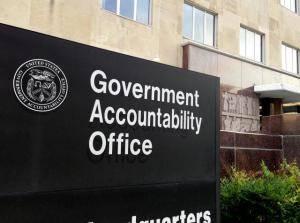

Federal real property management for another year is included on the Government Accountability Office's High-Risk List. Auditors say the government's excess...
Imagine your office, and think about how many people occupy that space — not just the number of people assigned to that area, but how much room is actually needed to house the workers who show up on any given day or in any given hour.
Now imagine you’re the General Services Administration, and you’ve got to think about that scenario with the government workforce and all of the federal real property in its portfolio.
“That’s where it starts to get very, very complicated,” said Robert Peck, former commissioner of GSA’s Public Building Service.
And that’s partially what the Government Accountability Office looked at when it flagged (as it has since 2003) federal real property management in its 2017 High-Risk List.
“The issues that GAO points to, about not having really great data about what buildings are occupied and to what extent … it’s true, but that is one of those things in which private sector people have the same kinds of problems,” said Peck, now a principal/co-leader for the Gensler firm’s Government Practice area, said. “There are some private corporations that are really, really good at what they do, but they have lots of dispersed real estate assets, and trying to figure out on any given day how many people are actually occupying them is hard to do. And that’s the data that’s really hardest to come by.”
According to the High-Risk List report, the government’s real property portfolio includes about 273,000 buildings that are leased or owned, and cost billions of dollars to operate and maintain.
Within that portfolio are vacant buildings, structures in disrepair, and as GAO outlined in its report, facilities that could face potential attacks due to security challenges.
“We recommended, in December 2015, that [the Federal Protective Service] and GSA — two agencies that share responsibility for protecting federal facilities — take actions to improve their collaboration and finalize the two agencies’ memorandum of agreement (MOA) accordingly,” GAO reported. “As of August 2016, FPS reported that it has taken steps with GSA to resolve differences in agency opinions on security-related authorities for protecting federal real property. However, progress toward an agreement is slow; the MOA has not been updated since 2006.”
GAO also recalled a report issued in January that found that foreign entities owned high-security space leased by GSA in 20 buildings, through 25 leases, as of March 2016. In that report, which GAO reiterated in its High-Risk List, auditors urged GSA to start sharing that information when an agency is considering a lease for a high-security purpose.
Physical security and guard training programs aside, GAO’s focus in its high-risk audit of real property management deals with an over-reliance on leasing properties. surplus buildings, and data reliability.
“GSA’s recent progress in reducing its reliance on leasing has been modest,” GAO reported.
According to the High-Risk List, GSA reported that the amount of space it leases fell for three straight years, but totals only a 4 percent drop since 2013.
But Peck pointed out that even big corporations rely on lease space, and while it’s one thing to buy property in a location where you know you’ll be for a long time, it doesn’t always make sense if you’re not sticking around. Not only that, but Congress only gives GSA so much money to buy and maintain buildings, Peck said.
“The alternative way of getting an asset that you own is to lease it over a period of time and then own it at the end of that time,” Peck said. “GAO notes that one of the problems GSA and the feds have in general is that if they do lease a good asset, they can’t — because of the way the government scores capital investments — they can’t own it at the end of that time.”
Another piece of red tape GSA has to hurdle when it comes to managing its properties, Peck said, is the Federal Buildings Fund,
GSA runs like a private real estate organization in that it charges rent to federal agencies and it charges a “commercial equivalent rent,” Peck said. This means there is some kind of profit embedded in the contract.
“In the case of GSA, Congress has always intended that that so called profit net income, be used to buy assets, renovate existing assets,” Peck said. “And then do one other thing GAO rightly notes is important these days, which is helping federal agencies reduce the amount of square footage they actually use by consolidating their space.”
But if GSA has a surplus it has to go to Congress and OMB to get permission to spend that, Peck said, and in most years GSA hasn’t been able to do that.
“So the Federal Buildings Fund now has billions of dollars in it that they don’t get to spend to buy assets or if it’s buildings that they’re currently leasing,” Peck said.
Two other related issues GSA is struggling with, according to GAO, is excess and underutilized properties, and reliable data. Managing excess and underutilized property is a challenge when real property data isn’t reliable, auditors explained in their report.
While the National Strategy for the Efficient Use of Real Property is a step in the right direction because the strategy highlights some of the problems federal agencies face when managing their portfolios, the strategy doesn’t address how those challenges impact the government’s ability to better use or dispose of properties.
“Furthermore, the strategy does not discuss alternative-funding mechanisms that we have previously identified to help manage budgetary constraints, such as retaining fees in real property and exploring enhanced use lease authority,” GAO reported.
And while OMB staff said they planned to expand the strategy to address long-term challenges, by the end of 2016, OMB had not made any changes, GAO said.
Addressing these challenges is going to remain difficult, GAO said, without “reliable real property data in the Federal Real Property Profile (FRPP).
“For example, our review found that some of the agencies estimated, rather than determined, actual operating costs for each building, as these agencies do not maintain data on costs for specific buildings,” GAO reported. “As a result, standardizing data has been challenging since agencies have applied different approaches to collecting data that align closely with their mission but that in some cases are inconsistent with existing GSA guidance.”
GAO did acknowledge the steps the government has taken to improve real property management, since the last High-Risk report in 2015.
Along with the National Strategy, and its companion Reduce the Footprint initiative, GSA in January 2016 launched a newer version of the Real Property Management Tool, which allows agencies to view leases and occupancy agreements, rent per square foot, operating and maintenance costs, and compare information on an agency or governmentwide level. The department also last summer stood up an Asset Consolidation Tool, which lets agencies see federal real estate in areas in certain geographic locations, which can help with consolidation efforts.
Another step in the right direction was the passage of two reform bills, GAO said.
The Federal Assets Sale and Transfer Act of 2016, and the Property Management Reform Act of 2016, “could address the long-standing problem of federal excess and underutilized property,” GAO reported.
Gene Dodaro, comptroller general of the U.S. and head of the GAO, told congressional committees last week that the laws are proof of progress.
The first piece of legislation creates an independent board “to make recommendations to sell or dispose of some high-value property that the federal government has,” Dodaro said. “That’s a good step forward, I believe.”
The second law codifies the Property Management Council and gives it a ‘to-do list.”
“Hopefully, it will result in a reduced reliance on leasing as well,” Dodaro said. “That’s an area that still needs to be addressed. The federal government leases some property for decades that it would have been far cheaper to build rather than lease. So, we’re trying to get the agencies to focus on some high value leases and doing a cost comparison in those areas. They’re starting to improve the accuracy of the information in the property management database. Some leadership, some strategies, good support from the Congress, all these are ingredients to the progress.”
Copyright © 2025 Federal News Network. All rights reserved. This website is not intended for users located within the European Economic Area.


